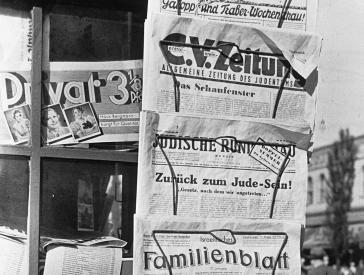“The First World War in Jewish Memory”
Press Information
Press Release, Tue 1 Jul 2014
- Insight into one of the world’s largest collections on the history of German Jews in the First World War
- Presentation of more than 170 objects from the holdings of the Jewish Museum Berlin
- Focus on the significance of the First World War in the collective memory of German-Jewish families
To mark the 100th anniversary of the outbreak of the First World War, the Jewish Museum Berlin is opening the cabinet exhibition "The First World War in Jewish memory" on 3 July 2014.
- Kontakt
-
Press office
T +49 (0)30 259 93 419
presse@jmberlin.de
- Address
Jewish Museum Berlin Foundation
Lindenstraße 9–14
10969 Berlin
More than 170 objects provide insight into one of the central collections of the Jewish Museum Berlin. In the 12-meter long display cabinet of the Rafael Roth Learning Center, the works on exhibit provide a personal look into the life of German-Jewish soldiers and their families during the First World War.
100,000 Jewish soldiers fought for Germany during the First World War. Thousands returned home with medals and honors for their service at the front. In 1934, many German Jews received the so-called "Cross of Honor," which Reich President Hindenburg bestowed on them on the occasion of the 20th anniversary of the beginning of World War I in 1914. More than twenty such crosses from the years 1934-1937 can be found in the Jewish Museum’s collection.
With its experiences of belonging and exclusion, the First World War plays a central role in the collective memory of German-Jewish families to this day. The more than 3000 objects of the Jewish Museum Berlin make up one of the world’s most important collections on the subject, alongside those of the Leo Baeck Institute in New York and the Central Archives for the History of the Jewish People in Jerusalem.
While they served at the Eastern Front, Jewish artists such as Hermann Struck, Jacob Steinhardt and Ernst Oppler encountered the religion and tradition of the Jewish population of Eastern Europe. Their drawings captured these formative experiences and encounters.
The illustration by Max Liebermann (1847-1935) entitled "The 10,000 Jewish soldiers who fell at the front" from the early 1920s is an emblematic depiction of all the mothers of fallen Jewish soldiers. It served as the draft for a lithograph that the Reichsbund jüdischer Frontsoldaten (Reich Federation of Jewish Front Soldiers) printed and sold in a larger format in 1924.
Most of the objects on display, such as military documents, letters, photographs, diaries, medals and private sketchbooks, illustrate the everyday life of war. They are part of family estates and were donated to the museum as private donations. The stories of the descendents and benefactors are also part of the history of these objects. They testify to how the memory of Jewish soldiers’ participation in the First World War is preserved within the families to this day, and how that is memory is inexorably linked with the ensuing catastrophe.
The Jewish Museum Berlin German-language collection database displays more than 1200 objects relating to the First World War.




